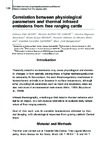Please use this identifier to cite or link to this item:
http://www.alice.cnptia.embrapa.br/alice/handle/doc/1061909| Title: | Correlation between physiological parameters and thermal infrared emissions from free ranging cattle. |
| Authors: | ALVES, F. V.  KARVATTE JUNIOR, N.   MASTELARO, A. P.   MIYAGI, E. S.   MENEZES, G. R. de O.   OLIVEIRA, C. C.   BUNGENSTAB, D. J.   |
| Affiliation: | FABIANA VILLA ALVES, CNPGC; NIVALDO KARVATTE JUNIOR, UFG; ARIADNE PEGORATO MASTELARO, UFPR-PR; ELIANE SAYURI MIYAGI, UFG; GILBERTO ROMEIRO DE OLIVEIRA MENEZE, CNPGC; CAROLINE CARVALHO OLIVEIRA, UFMS; DAVI JOSE BUNGENSTAB, CNPGC. |
| Date Issued: | 2016 |
| Citation: | In: INTERNATIONAL SYMPOSIUM ON GREENHOUSE GASES IN AGRICULTURE, 2., 2016, Campo Grande, MS. Proceedings... Brasília, DF: Embrapa, 2016. 502 p. (Embrapa Gado de Corte. Documentos, 216). Coordenador Roberto Giolo de Almeida. II SIGEE |
| Pages: | p. 126-129 |
| Description: | Thermally stressful environments may cause physiological and metabolic changes in farm animals, among these, a higher methane production by ruminants. In this context, the main thermoregulatory mechanism in homeothermic animals is an increase in surface temperature, although other physiological parameters such as heart and respiratory rates are also indicative of environmental heat stress (Hahn, 1985; Bouzida et al., 2009). Infrared thermography, a technique that detects thermal radiation emitted by an object, is a non-invasive alternative to evaluate body temperature of free ranging animals. Goal of this work was to correlate temperatures obtained by thermal imaging with physiological responses from grazing cattle in Central Brazil. |
| Thesagro: | Ruminante Temperatura |
| NAL Thesaurus: | Cattle Thermography Thermal radiation Ruminants |
| Type of Material: | Artigo em anais e proceedings |
| Access: | openAccess |
| Appears in Collections: | Artigo em anais de congresso (CNPGC)  |
Files in This Item:
| File | Description | Size | Format | |
|---|---|---|---|---|
| Correlationbetweenphysiological.pdf | 634,28 kB | Adobe PDF |  View/Open |









